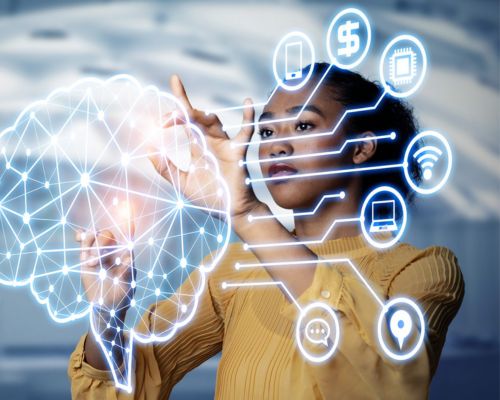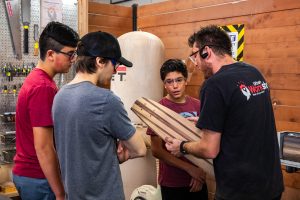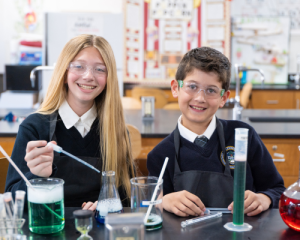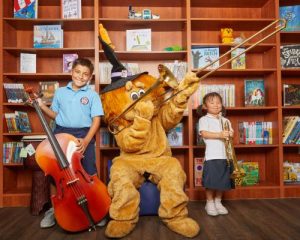How artificial intelligence may impact the future educational landscape here and beyond.
Baby Boomers were the first to be raised with television. Gen Xers the first with home computers. Millennials the first to grow up in the information age. The Internet, mobile devices and social media became second nature for Gen Z. And for better or worse, they are considered the first “digital natives.”
However, Generation Alpha — born since the early 2010s — will be the first to grow up with artificial intelligence in their everyday lives. The first to incorporate computer systems with characteristics similar to our brains as a way to learn more, be better at their jobs and do other things we can’t even imagine yet.
But since “Frankenstein,” we have pondered the possibilities of our creations becoming a monster we can’t control. Writers Mary Shelley and Arthur C. Clarke warned us of what could go wrong, while Isaac Asimov reminded us of how we could get it right. The possibilities presented by recent AI tools like ChatGPT are not Hal 9000. At least not yet. It’s a tool of such vast potential that is still so new, society has been presented with a unique opportunity to listen, to learn and to get it right. And ultimately to pass on something that would make Asimov proud. Something that truly makes the world a better place.
Stephen Hawking told a Cambridge University audience in 2016 that AI would be “either the best, or the worst thing, ever to happen to humanity.” In 2018, Google CEO Sundar Pichai told MSNBC it was “more profound than … electricity and fire.” Elon Musk and Bill Gates have both urged cautious, careful research.
Experts praise its potential uses in medicine, environmental sciences, combating world hunger and to filter out misinformation in social media and the Internet. But the biggest worries include the spreading of misinformation, eliminating certain human work forces and privacy loss.
“We’re entering a time of great uncertainty, where we’re dealing with the kinds of things we’ve never dealt with before,” said former Google executive Geoffrey Hinton, a godfather of AI, to PBS NewsHour a few days after he quit the tech giant in early May to focus his attention on educating the public about AI. “I think we should put more or less equal resources into developing AI to make it much more powerful and into figuring out how to keep it under control and how to minimize bad side effects of it.”
Hinton described the “tremendous good you can do with it,” but said the problem is both the people and the technology, and he went public to encourage more research and development by “smart, careful people.”
A few days later, even OpenAI CEO Sam Altman, whose company is the maker of ChatGPT, appealed to Congress to regulate artificial intelligence to “mitigate the risks.”
AI in OC Classrooms
Artificial intelligence has existed in some form or another for decades. But its baptism into education has been slow.
“Most of the universities freaked out because everybody was writing their dissertations and most of the professors wanted to shut it down,” said Humanities Coordinator for the Orange County Department of Education Virginia Reischl, Ed. D. “The immediate fear was plagiarism, but it’s not plagiarism, it’s having somebody write it for you. With everything new, we’re learning its pros and cons. Its promise and its perils.” Reischl points out it’s already being used in adaptive learning and in teacher assessments for students. “This,” she said, “is just another aspect of it.”
Since the release of ChatGPT — a publicly available version of AI — in November 2022, Orange County public schools have yet to develop any broad official policy about, or any broad program using AI. It’s just too new. That is likely to change soon. It is not a question of if, it is only when and how.
Though a few OC public schools have experimented with AI, including a Fullerton school that has used it to help special needs students develop art, it is largely an unknown quantity. But getting educators and students working with it soon could be key in determining the future.
“As an education technology team we’re committed to learning more about the various AI platforms and what that means for our staff and students,” said Capistrano Unified School District’s Reannah Sartoris. “Our district’s mission is ‘to prepare our students to meet the challenges of a rapidly changing world’ and currently that includes the development of artificial intelligence platforms and their impact on education.”
Sartoris’ view is largely representative of most other public school districts in the county. However, some private schools have already tried to make friends with it.
Fairmont Schools has been using AI since 2019 and has found it neither a tutor nor a new version of CliffNotes. It is a different and more powerful learning and teaching aid. While the school embraces technology and innovation, they keep a clear idea of what role it should play.
“AI has the potential to revolutionize the way we teach and learn, offering personalized experiences, data-driven insights and innovative tools to enhance educational outcomes,” said Kristen Jansen, Fairmont’s director of education. “However, it’s crucial to maintain a balanced approach that acknowledges the enduring importance of teaching basic skills and nurturing critical thinking.
“It can automate specific tasks and provide valuable support,” she said. “It cannot replace the human touch that fosters creativity, empathy and the ability to think critically.” Jansen describes it as a powerful tool that helps create a “dynamic and inclusive learning environment.”
But even with its current usage, Fairmont still has no official policy or plan with it.
“We can’t make policies now that mean the same thing in August, because it’s changing too fast,” Jansen said.
But one thing is certain according to those who’ve learned how to use the new tool: It’s only as good as the information we enter into it. In other words, the better and more exact the prompts, the more useful the response. The more effective the tool becomes.
In 1997, IBM’s Deep Blue defeated chess grandmaster Garry Kasparov, changing the chess world forever. But not in the ways you’d think. The best in chess didn’t get replaced by AI, they used it as a tool to get better. A lot better. And it serves as perhaps a great example for educators, parents and students.
Reischl said it helps educators “get through work quicker, so we can spend more time being creative and innovative.” Teachers don’t “have to formulate, they can focus on asking those questions and being able to have those meaningful human interactions.”
She said she helped a group of elementary school teachers work up a way to help a student research the California Gold Rush using ChatGPT. In minutes, it developed an outline of different topics. The student could find what was interesting to them and then write about it, eliminating the anxiety many students have about how to begin writing on a subject.
“I asked ChatGPT earlier today, ‘What are some positive uses for you in education?’ and one of the responses was ‘to create outlines, to create bullet points and to help student learning in organizing their thoughts’ because the anxiety for students has always been writing,” Reischl said. “Then they’re ready to be creative. To be innovative.”
Learning from Past Mistakes
Educational consultant and “Designing Schools” podcaster Sabba Quidwai has advice for educators wondering what the future is with AI.
“It’s a moment to reclaim your value,” Quidwai said. “It’s a time to learn and lead at a time when society has no idea what’s next. You have an opportunity to not just educate your students, but to educate and influence communities. This technology presents an opportunity to return to what teachers do best — build rapport and relationships with students.”
The opportunity to make up for some of the distance social media has created has also arrived.
“This isn’t just about integrating AI,” Quidwai said, “it’s about asking what do humans do best, what do machines do best, what does that relationship look like, and what knowledge, skills and mindsets do we want our students to have, and how will we help them get there. Then we examine the role AI plays, and other technologies. With this approach, it doesn’t matter what comes tomorrow, you have the mindset and skills to navigate ambiguity with curiosity and confidence.”
Quidwai urges schools to host AI roundtables in the fall. “Engage parents, students and businesses in conversation. Design with people, not for them. It’s a moment for partnership and collaboration among everyone.”
Reischl said it’s a moment to think ahead. “Our job as educators is to get students ready for their future, not our future. In our classrooms right now are the next ChatGPT and computer science geniuses. We want to teach them to use these tools so they put the humanity into it. If we shut all this down and hide technology from them, we’re doing ourselves a disservice, because AI is not going anywhere. We want them to make it better for us.”










Leave a Reply